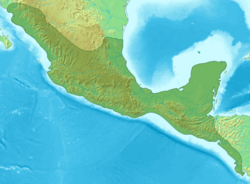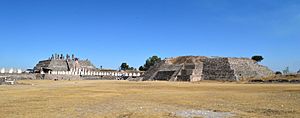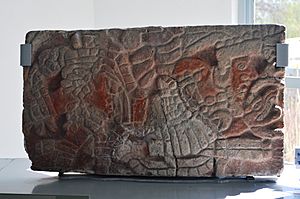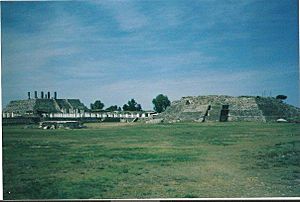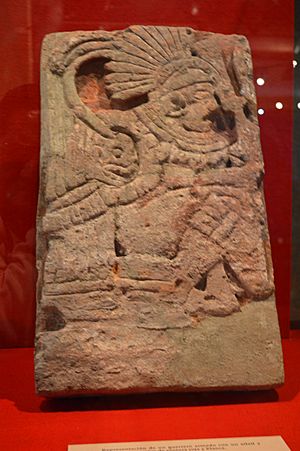Tula (Mesoamerican site) facts for kids
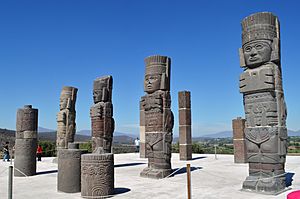
Atlantean columns on Pyramid B in form of Toltec warriors.
|
|
| Location | Tula de Allende, Hidalgo, Mexico |
|---|---|
| Coordinates | 20°3′50.96″N 99°20′26.89″W / 20.0641556°N 99.3408028°W |
| History | |
| Periods | Late Preclassic to Late Classic |
Tula is an ancient city in Mesoamerica, a historical region in North and Central America. It was a very important center and the capital of the Toltec Empire. Tula became powerful after the city of Teotihuacan declined and before the rise of Tenochtitlan, the Aztec capital.
Even though Tula was important, it hasn't been studied as much as Teotihuacan or Tenochtitlan. Experts still debate how it was governed and how it connected with other ancient cities like Chichen Itza. The site is in the modern city of Tula de Allende in the state of Hidalgo, Mexico. The archaeological site has a museum, remains of an older settlement called Tula Chico, and the main ceremonial area called Tula Grande. The most famous part is the Pyramid of Quetzalcoatl. It has four tall stone columns, each about 4 meters (13 feet) high, carved to look like Toltec warriors. Tula fell around 1150 CE, but it greatly influenced the later Aztec Empire. The feathered serpent god Quetzalcoatl is strongly linked to this city. This god was worshipped across a wide area when the Spanish arrived.
Contents
Exploring the Ancient City of Tula
The ancient city of Tula is very important for understanding the history of Mesoamerica, especially the central highlands of Mexico. However, it is often less known than the earlier city of Teotihuacan and the later city of Tenochtitlan. The name Tula comes from the Nahuatl phrase "Tollan Xicocotitlan," which means 'near the cattails.' The Aztecs used the word "Tollan" to mean 'urban center,' and they also used it for other big cities like Teotihuacan and Tenochtitlan.
The people of Tula were called Toltecs. Over time, the word "Toltec" came to mean a skilled person, like an artisan or a city dweller. This shows how much the people in the Valley of Mexico respected this ancient civilization before the Spanish conquest of the Aztec Empire.
Where is Tula Located?
The remains of this ancient city are in the southwest of the modern state of Hidalgo, about 75 kilometers (47 miles) north of Mexico City. It sits in the Tula River Valley, which is part of a larger area called Teotlapan, meaning "land of the gods." This area is high up, between 2,000 and 2,200 meters (6,560 and 7,200 feet) above sea level. It has a dry climate with only a few rivers, the largest being the Tula River. There are also streams that flow only during the rainy season.
What Can You See at the Site?
Today, the archaeological site includes the main ceremonial area called Tula Grande. There's also an older section called Tula Chico. Visitors can explore the Jorge R. Acosta site museum and the Guadalupe Mastache Orientation Center. The museum is named after an archaeologist who worked at the site for many years. Inside, you can see carved stones and human remains. The Orientation Center has more ancient artifacts and displays that explain Tula's importance.
The city's main buildings are lined up about 17 degrees east of true north. This is similar to how buildings at Teotihuacan were aligned. The main part of the city is on a limestone hill, making it easy to defend. Images of war and sacrifice are common here. You can see jaguars, coyotes, and eagles eating human hearts, which represent warriors. There are also images of snakes eating skeletons and skulls.
Key Buildings and Features
The main ceremonial area has two pyramids, including the one with the famous warrior statues. There are also two large Mesoamerican ballcourts, where ancient games were played. Several big buildings with columns faced a large open plaza. This plaza was big enough for 100,000 people!
The architecture shows a change in how ceremonies were done. Instead of small rituals in closed spaces, Tula had large public ceremonies for many people to watch. These ceremonies were often led by warriors.
The most famous part of the site is Pyramid B, also known as the Pyramid of Quetzalcoatl or the Morning Star. It has five levels, similar to the Temple of the Warriors at Chichen Itza. At the top of Pyramid B are four huge stone columns. These are carved to look like Toltec warriors and once held up the roof of a temple. Each warrior statue is made of basalt, stands four meters (13 feet) tall, and holds an atlatl (a spear thrower). They also wear special chest plates and back plates.
In front of the pyramid is a large entrance area that connects to nearby buildings. One of these, Building C, is also called the Burnt Palace because there's evidence it was burned. Around this pyramid is the Coatepantli, or serpent wall. This wall later inspired a similar structure in Tenochtitlan.
The Story of Tula
The first settlements in the Tula area appeared around 400 BCE. Tula was likely settled by different groups of people, possibly including the Nonoalcas from the south and the Chichimecas from the north. During the Epiclassic period, the area might have been controlled by Teotihuacan. This is suggested by Teotihuacan designs found on Tula pottery. The area's lime deposits were important for making plaster used in building.
At this time, Tula was a small town with simple public buildings, mostly in Tula Chico (Small Tula). Tula Chico was active from 650 to 900 CE. It grew between 650 and 750 CE, covering about five to six square kilometers. Its population was between 19,000 and 27,000 people at its peak. Tula Chico was abandoned between 850 and 900 CE, and then Tula Grande began to grow. After Teotihuacan declined, many smaller city-states became powerful. Tula's pottery styles changed during this time, showing new influences. People also started living on hilltops for better defense. The architecture and pottery show influences from different regions, suggesting that many different groups lived in Tula.
Tula's Golden Age
Tula became very important after Teotihuacan fell. It reached its peak between 900 and 1150 CE. Tula Grande (Big Tula) grew larger than any other city of its time, but it never became as big as Teotihuacan. At its height, the city probably covered 14 square kilometers (5.4 square miles) and had about 60,000 people. Another 20,000 to 25,000 people lived in the surrounding area. Tula had defenses against the Chichimecas. Its influence likely spread across most of Hidalgo and into the Valley of Mexico. This is often seen by comparing pottery found in different areas.
Tula was a fertile region with obsidian mines and was on an important trade route. Its economy relied on farming and on mining and shaping obsidian. About half of the people in Tula worked with obsidian, as well as with travertine stone and pottery. Tula likely didn't rule a huge empire but might have controlled a regional state. Trade with distant places is shown by pottery from eastern Mesoamerica, special grey-green pottery from southern Guatemala, and colorful pottery from Costa Rica. Tula probably traded its obsidian in return.
Tula society likely had a ruling class, skilled craftspeople, merchants, and many farmers. Most farmers lived outside the city. Excavations show they grew chili peppers, amaranth, squash, maguey, corn, and beans. They also gathered wild plants like mesquite beans and cactus fruit. They raised turkeys and dogs. Irrigated corn was the most important crop.
It is believed that the Toltecs had a form of hieroglyphic writing, but only a few symbols have been found on buildings.
The Decline of Tula
Tula did not last as long as some other Mesoamerican civilizations. Around 1000 CE, problems like soil erosion and a drier climate began. This caused the Chichimecas to move south from their drying lands, leading to conflicts. Many homes seem to have been abandoned by 1150 CE. We don't know exactly when the main ceremonial center fell, but it was burned and the pyramids were damaged. There is evidence of the ceremonial center being burned in the 12th century. Old stories mention other rulers and a king list. Some stories say Tula was destroyed around 1179 CE under the rule of Ce Acatl Topilitzin, but this is debated.
After Tula's fall, the site was looted. However, people continued to live there through the rest of the Mesoamerican period and into the colonial period. According to Bernardino de Sahagún, skilled workers like scribes, stonecutters, masons, and potters were still found in Tula when the Spanish arrived.
Archaeologists confirmed Tula was the site of Tollan and the Toltecs through studies from the 1950s to the 1970s. However, Tula is still not fully understood, especially how it relates to Teotihuacan. There isn't even a detailed map of the entire city. Many studies suggest Tula became the main power after the Epiclassic cities fell, but some archaeologists believe its peak was earlier. Some old ideas about Tula were wrong; for example, it did have a grid system for its streets, and large residential complexes have been found. The elite also had access to very fine handcrafted items. The exact size and nature of Tula's political power are still debated because there are no written records and not much archaeological evidence.
Tula's Impact and Legacy
Tula's influence can be seen in other parts of Mesoamerica, mostly through pottery styles. One of the biggest questions is how Tula might have been connected to Chichen Itza, a city far to the south in the Yucatán Peninsula. This idea comes from similarities in their art and architecture. It's clear that neither city conquered the other, but they might have been connected through trade networks.
By the time the Spanish arrived, Quetzalcoatl, the feathered serpent god, was widely worshipped. This god is linked to a legendary ruler of Tula, Ce Acatl Quetzacoatl, who was often simply called Quetzalcoatl. Myths about Tula's fall say this ruler gave in to temptation from a dark god named Tezcatlipoca, which led to the city's destruction. The fallen ruler then wandered to the Gulf Coast, burned himself, and became the morning star (Venus).
The history of Tula remained important even during the Aztec Empire. Stories about Tula are found in ancient books called codices, written after the Spanish conquest. However, many of these stories are mixed with myths. They often start with the Toltecs and the city of Tula, followed by the journey of the Mexica people to the Valley of Mexico. These stories sometimes show Tula as a paradise where people mastered science and art, or as a city full of conflict heading for ruin. In these tales, the last ruler, Quetzalcoatl, is a legendary figure with special qualities.
Much of Toltec history was lost when Izcoatl, an Aztec emperor, burned many history books after founding the Aztec Empire. However, the way Tula was planned influenced how some Aztec city-state rulers designed their own cities.
Tula National Park
The archaeological site was made a national park by the Mexican government in 1981. The park covers an area of 1 square kilometer (0.39 square miles).
Images for kids
See also
 In Spanish: Tollan-Xicocotitlan para niños
In Spanish: Tollan-Xicocotitlan para niños


